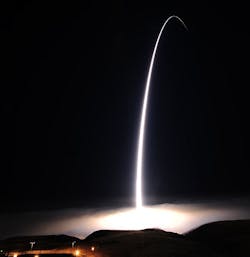Air Force asks Boeing to upgrade test gear for nation's Minuteman III nuclear missiles
Officials of the Air Force Nuclear Weapons Center at Hill Air Force Base, Utah, announced a $110.1 million contract Friday to the Boeing Defense, Space & Security segment in Layton, Utah, to replace the Minuteman III intercontinental ballistic missile (ICBM) telemetry, test, and termination systems.
The Minuteman III's telemetry, test, and termination systems are packaged in a wafer-like package called the Mod 7 that fits on test versions of the Minuteman between the missile's reentry system and missile guidance set.
The Mod 7 wafer that contains the telemetry, test, and termination systems is installed only on missiles that will be test fired from Vandenberg Air Force Base in Central California to an impact site in the Pacific Ocean near the Ronald Reagan Ballistic Missile Defense Test Site on Kwajalein Atoll.
The Air Force conducts Minuteman III test firings from Vandenberg about three times a year to test the missile's performance and reliability. For these tests, Air Force experts choose deployed Minuteman III missiles at random, ship them to Vandenberg, remove their nuclear warheads, and fit them with test equipment that includes the Mod 7 wafer package.
Related: Draper Lab to help enhance accuracy and power of Navy's submarine-launched nuclear missiles
The Mod 7 package with ICBM telemetry, test, and termination systems transmit data from sensors aboard the test missiles that monitor the missile's behavior before and during flight. The telemetry, test, and termination systems transmit telemetry in real time on the missile's critical on-board components like batteries booster stage pressure chambers, and guidance section.
The Mod 7 package also contains flight tracking and terminal components that enable Air Force personnel to destroy the missile in flight if it performs poorly and takes the wrong path. Tests like these are essential for ensuring nation's Minuteman III land-based nuclear missile fleet would perform reliably if needed.
The U.S. Minuteman III fleet constitutes one-third of the nation's nuclear weapons deterrent. Other U.S nuclear warheads are on submarine-launched ballistic missiles and on manned jet bombers.
Related: Nuclear ballistic missile command and control technology still a prime military concern
The U.S. maintains Minuteman III missiles at 450 missile sites in Colorado, Montana, Nebraska, North Dakota, and Wyoming. The missiles themselves are in underground silos and are ready for launch on very short notice.
Each Minuteman III missile is 60 feet tall, 5.5 feet in diameter, and powered by three solid rocket motors that can launch the 80,000-pound missile t altitudes of 700 miles to deliver nuclear warheads as far away as 6,500 miles. Each missile contains as many as three independently targeted warheads in separate reentry vehicles.
On this contract Boeing will do the work in Layton, Utah; Huntington Beach, Calif.; and Heath, Ohio, and should be finished by August 2019. For more information contact Boeing Defense, Space & Security online at www.boeing.com/defense, or the Air Force Nuclear Weapons Center-Hill Air Force Base at www.hill.af.mil.
